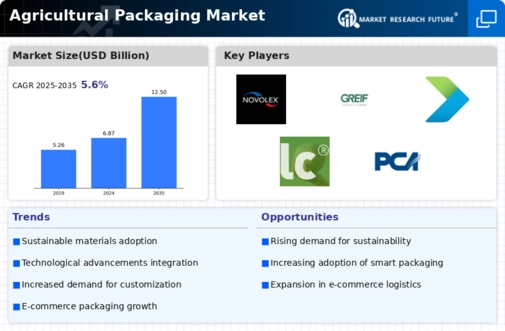Market Growth Projections
The Global Agricultural Packaging Market Industry is projected to experience substantial growth in the coming years. With an estimated market value of 6.87 USD Billion in 2024, the industry is on track to reach 12.5 USD Billion by 2035. This growth trajectory indicates a compound annual growth rate (CAGR) of 5.61% from 2025 to 2035. Factors contributing to this expansion include the increasing demand for sustainable packaging solutions, technological advancements, and the rising consumption of fresh produce. As the market evolves, stakeholders are likely to focus on innovation and sustainability to capture emerging opportunities and address the challenges posed by changing consumer preferences.
Global Trade and Export Growth
The expansion of global trade and export activities is a significant driver for the Global Agricultural Packaging Market Industry. As countries engage in international trade, the need for effective packaging solutions that comply with various regulations becomes paramount. Packaging must not only protect products during transit but also meet the standards of different markets. This is particularly relevant for agricultural products, which often face stringent quality checks. The growth in exports of agricultural goods is expected to propel the demand for innovative packaging solutions that enhance product appeal and ensure compliance. This trend is likely to contribute to the overall market growth, reflecting the interconnectedness of global supply chains.
Rising Demand for Fresh Produce
The Global Agricultural Packaging Market Industry is significantly influenced by the rising demand for fresh produce. As consumers become more health-conscious, the preference for fresh fruits and vegetables is increasing. This trend necessitates efficient packaging solutions that preserve freshness and extend shelf life. Packaging that incorporates modified atmosphere technology is gaining popularity, as it helps maintain the quality of perishable goods during transportation and storage. The growing emphasis on food safety and quality assurance further drives this demand. Consequently, the agricultural packaging sector is likely to witness robust growth, aligning with the projected CAGR of 5.61% from 2025 to 2035.
Sustainable Packaging Solutions
The Global Agricultural Packaging Market Industry is increasingly driven by the demand for sustainable packaging solutions. As environmental concerns rise, consumers and businesses alike are seeking eco-friendly alternatives. Biodegradable and recyclable materials are gaining traction, with a notable shift towards plant-based plastics. This trend is reflected in the projected market growth, with the industry expected to reach 6.87 USD Billion in 2024. Companies that adopt sustainable practices not only enhance their brand image but also comply with stringent regulations aimed at reducing plastic waste. This shift towards sustainability is likely to shape the future of agricultural packaging, influencing product design and material selection.
Consumer Awareness and Preferences
Consumer awareness regarding packaging materials and their impact on health and the environment is shaping the Global Agricultural Packaging Market Industry. As consumers become more informed, they are increasingly favoring products with transparent labeling and sustainable packaging. This shift in consumer preferences is prompting manufacturers to adopt eco-friendly materials and innovative designs that resonate with environmentally conscious buyers. The demand for packaging that minimizes environmental impact is expected to drive market growth, as companies strive to meet these evolving consumer expectations. This trend underscores the importance of aligning packaging strategies with consumer values, which is likely to influence purchasing decisions in the agricultural sector.
Technological Advancements in Packaging
Technological innovations are playing a pivotal role in the Global Agricultural Packaging Market Industry. Advancements such as smart packaging, which incorporates sensors and QR codes, enhance traceability and product safety. These technologies allow for real-time monitoring of product conditions, thereby reducing spoilage and waste. As the industry evolves, the integration of automation and robotics in packaging processes is also becoming more prevalent. This could lead to increased efficiency and reduced labor costs. The adoption of such technologies is expected to contribute to the market's growth, potentially reaching 12.5 USD Billion by 2035, as businesses seek to optimize their operations and improve product quality.








Leave a Comment